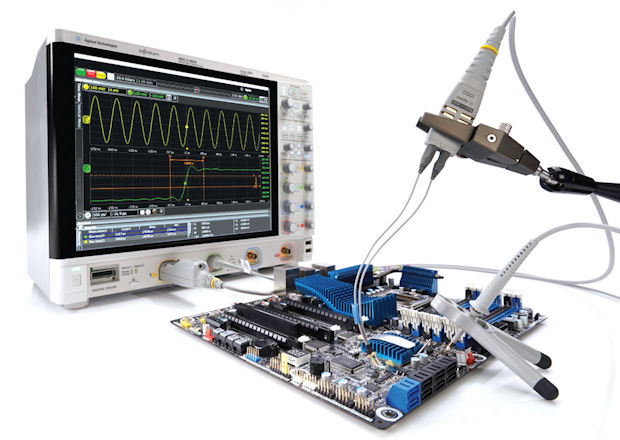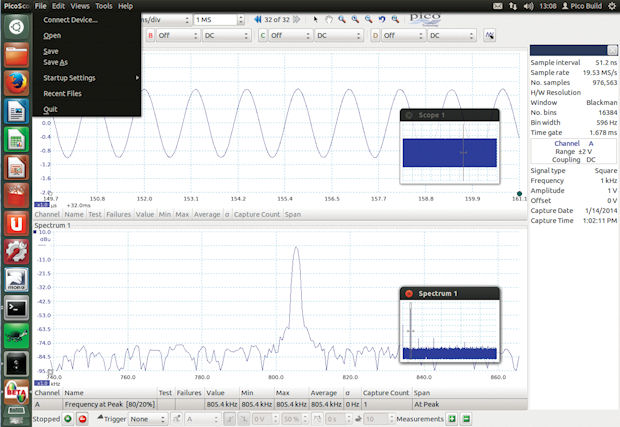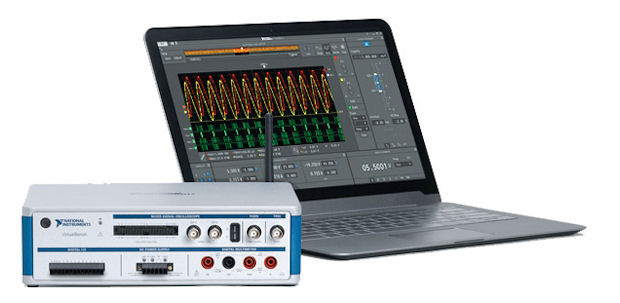
Latest News
July 1, 2014
 The Infiniium S-Series touts the industry’s best signal integrity with the first 10-bit ADC for four times more vertical resolution than traditional 8-bit scopes, as well as a low-noise front. Image courtesy of Agilent Technologies.
The Infiniium S-Series touts the industry’s best signal integrity with the first 10-bit ADC for four times more vertical resolution than traditional 8-bit scopes, as well as a low-noise front. Image courtesy of Agilent Technologies.Oscilloscopes are continuing their march to embrace modern technologies with the current focus on integrating multiple domains into a single instrument, new usability capabilities and the never-ending quest for higher bandwidth and signal clarity.
While general-purpose oscilloscopes remain a staple of the engineering workbench, the growing complexity of electronics devices, the proliferation of wireless capabilities into all kinds of products and the more stringent requirements around power efficiency are all upping the ante for additional functionality to be used in conjunction with the base oscilloscope in a more efficient fashion. In addition, the general trend toward high-speed input/output connections like PCI Express and USB is driving demand for higher-speed oscilloscope capabilities—along with faster throughput.
As a result of these trends, we’re seeing the rise of the multi-domain instrument, with leading oscilloscope vendors—including National Instruments, Agilent, Tektronix, Pico Technologies and others—integrating more functionality as part of a single device, according to Prathima Bommakanti, an industry analyst with Frost & Sullivan.
“Users prefer to use the same instrument for different applications in their workflow,” Bommakanti says, adding that spectrum analyzers, logic analyzers, function generators and other capabilities are becoming standard on the core oscilloscope. “Users have a need for different capabilities, but they are requesting one box for testing.”
While demand for multi-domain oscilloscopes is on the rise, there is still demand for the standalone, general-purpose oscilloscope, Bommakanti says. Frost & Sullivan projects the market for oscilloscopes of all kinds to be $1.15 billion for 2013, up slightly from the $1.1 billion in 2012. The firm is anticipating continued growth for the category, projecting a calculated annual growth rate (CAGR) of 7.2% from 2012 to 2019.
All-in-one Device
National Instruments is the latest company to put its spin on the concept of a multi-domain testing device with its introduction of VirtualBench, which integrates five instruments into an all-in-one device. VirtualBench, which is based on NI’s software-based approach to test and measurement, incorporates a mixed-signal oscilloscope, function generator, digital multi-meter, programmable PC power supply and digital I/O. The system interacts with users through software applications running on a PC or iPad.
Unlike NI’s previous oscilloscope offerings, which played in the automated test space for validation after an electronics product or circuit board was produced, VirtualBench is the company’s first offering aimed at early-stage design and as a go-to test tool for the engineer’s workbench. “We like to think of it as a Swiss Army knife—it’s there on the bench and engineers can pull it out and do whatever they need to do,” explains Chris Delvizis, NI’s senior product manager.
 Pico Technologies’ PicoScope software, now available for Windows and soon to be offered on Linux, delivers an oscilloscope, spectrum analyzer and signal/waveform generator all in one. Image courtesy of Pico Technology.
Pico Technologies’ PicoScope software, now available for Windows and soon to be offered on Linux, delivers an oscilloscope, spectrum analyzer and signal/waveform generator all in one. Image courtesy of Pico Technology.In addition to taking up minimal space on a desktop or benchtop, VirtualBench simplifies instrument configuration through NI’s software approach. This latest offering sports a user interface (UI) that mimics some of the touch and gesturing conventions popularized by consumer electronics devices, Delvizis says. “The big change here is that some of the modern UI patterns have really evolved, and we’re trying to take advantage of them to provide an experience that’s as good as all the knobs and [physical] instrument controls, but better,” he adds. “Another key benefit is being able to use the PC or mobile device, which lets us take advantage of all of the technology already built into those products.”
VirtualBench’s $1,999 price tag—and the fact it takes up limited desktop space—makes this type of instrument more accessible. It also opens up new possibilities for how engineers can utilize benchtop instruments, says Russell Stanphill, electronics advisor at TechShop, a maker community and workspace.
“The nice thing is that this is an out-of-the-box experience—you turn it on and the screen turns into the instruments on your device, whether it’s a laptop or an iPad,” he explains. “It’s a winner because of the amount of functionality, the affordability of that functionality, and fact that it packages everything I need into one box.” VirtualBench’s integration with LabVIEW is another plus, Stanphill says, as it facilitates the ability to do repetitive measurements or characterization of a design.
Tektronix has been focused on multi-domain, mixed-signal oscilloscopes for the last few years. It’s part of its product development charter, which is all about helping engineers find the answers to problems in seconds instead of days or weeks, according to Gina Bonini, the company’s technical marketing manager. For example, given the rise of wireless radio capabilities in embedded systems, Tektronix was the first to pair an oscilloscope with a spectrum analyzer—in recognition that its customers needed a better way to coordinate testing among domains.
Tektronix research showed that more than 25% of oscilloscope users employ a spectrum analyzer multiple times per week, and more than 40% of embedded design projects include some form of wireless capability; hence the impetus to pair the two instruments together.
“Previously, engineers had an oscilloscope and a spectrum analyzer, and nowhere were they connected,” she explains. “What that means in the world of wireless radio is that customers were not able to do basic timing measurements between time and frequency domains, which is a really key measurement that needs to happen. We’ve integrated the most common instrument used side-by-side with an oscilloscope into the oscilloscope itself, and that’s huge in terms of convenience and cost savings.”
While the MDO4000 Mixed Domain Oscilloscope series broke ground in this arena, Tektronix followed up in February with the release of the MDO3000. The new series has slightly less functionality—but with a price tag starting at $3,350, it’s targeted to the mainstream portion of this market. The MDO3000 includes a spectrum analyzer, logic analyzer, protocol analyzer, arbitrary function generator and digital voltmeter, but it has been designed so users can add or customize other functionality at a later date. For example, they can implement performance upgrades for input frequency, or functional upgrades such as the addition of digital channels or protocol analysis, among other capabilities.
 National Instruments’ VirtualBench combines five instruments in a single device, and interacts with users via software that runs on PCs or an iPad. Image courtesy of National Instruments.
National Instruments’ VirtualBench combines five instruments in a single device, and interacts with users via software that runs on PCs or an iPad. Image courtesy of National Instruments.The MDO3000 features two or four analog input channels, with bandwidth ranging from 100 MHz to 1 GHz, 16 digital channels (optional), and one RF input channel. Other notable features include an optional integrated 50 MHz AFG functionality with eight times the arbitrary waveform record length; more than 280,000 waveforms per second capture rate displayed on a digital phosphor display for easily finding infrequent anomalies in a signal; and more than 125 available trigger combinations.
Speeds and Feeds
In addition to integrating multiple domains, oscilloscope vendors have been on a tear to push the bandwidth and signal integrity of their offerings. “The race has been on to develop oscilloscopes that have more bandwidth than their predecessors, are wider to support more channels, and are deeper so they have more memory, so engineers can look back in time and see where the problem lies,” explains Trevor Smith, business development manager, test and measurement for Pico Technology. “The faster, wider, deeper and better resolution electronics engineers have, the better visibility they have to the problem they’re working on so they can design a fix.”
Pico’s sweet spot is around the “deeper” part of the race, pushing the boundaries of onboard memory to allow engineers the flexibility to dig deep into the data to find the problem. The company’s mainstream offering, the PicoScope 4824, is an 8-channel, high resolution, deep memory compact scope supporting 12-bit vertical resolution, bandwidth of 20 MHz, a fast sampling rate of 80 MS/s, and 256 MS buffer memory. The PicoScope 6000 offers ultra deep memory with up to 2 GSample buffer memory compared to industry standards, which are around 20 MSamples.
“Say, for example, you needed to look at a 60 Hz mains signal over a long period (minutes or hours) and capture the entire waveform to guarantee that you will record each and every transient or dropout, with good resolution, that might occur in that time,” Smith explains. “Twenty samples per waveform might be good enough resolution, so one minute of capture would require 20 x 60 x 60 = 72,000 sample points. Most scopes today can do that. But an hour would require 20 x 60 x 60 for a total of 4.32 million samples, and a day would require over 100 million samples. Very few scopes have that buffer memory, but PicoScope does.”
For its part in the race, Agilent Technologies recently introduced a pair of oscilloscopes—one the company intends to set new standards around price/performance, and the other putting measurement accuracy in its sights.
The Infiniium S-Series tackles the issue of signal integrity for bandwidths up to 8 GHz via a new low-noise front end and a fast, 10-bit analog to digital converter (ADC) that has four times the vertical resolution for precise viewing of signal detail compared with traditional scopes that offer an 8-bit ADC, according to Richard Markley, product planner at Agilent. The series, designed for validation and compliance of already-built devices, includes bandwidths from 500 MHz to 8 GHz with four-channel digital storage (DSO) models and 16-digital-channel mixed signal (MSO) models.
To ensure the scope stays responsive in all operating modes, the S-Series comes with application-specific measurement software fueled by a motherboard stocked with 8GB of RAM, along with a solid-state drive (SSD) for increased reliability. There’s also a 15-in. multi-touch capacitive display for optimal visualization. Pricing for the series ranges from $17,500 to $73,000, depending on the configuration.
Agilent’s second offering is the InfiniiVision 6000 X-Series, which delivers 6 GHz of bandwidth at a price point starting at $29,500—which Markley says is less than half the price of competitors’ models with comparable bandwidth. The scope family also ups the ante for integration of other domains, incorporating an oscilloscope, logic analyzer (MSO), protocol analyzer, dual-channel WaveGen function/arbitrary waveform generator, digital voltmeter, and a 10-digit counter totalizer. This model is designed to handle the debugging and troubleshooting process as part of early design, Markley says.
This lineup includes two- and four-channel DSO and MSO models with 16 digital channels and with bandwidths from 1 GHz to 6 GHz at 20-GS/s sample rates; the InfiniiVision 6000 X-Series small size (15 lbs. and about 6 in. long) are about one-third the size of similar bandwidth scopes, setting a new standard in portability, he explains. Pricing for the InfiniiVision 6000 X-Series ranges from $14,900 to $42,500, depending on the configuration and options.
Following in the footsteps of the InfiniiVision 4000, the 6000 X-Series has a capacitive touchscreen and incorporates many of the capabilities users are accustomed to with their smartphones and tablets. “It’s got all the things you’ve come to associated with tablets and smartphones, but it goes beyond just telling the scope you want to pinch and zoom,” Markley says.
All of these developments spell one thing for engineers: Options to match the oscilloscope to the need. “Customers who’ve used spectrum analyzers before can [choose to] not use oscilloscopes; there are oscilloscopes of any bandwidth; and there’s a convergence between oscilloscopes and other analyzers,” Frost & Sullivan’s Bommakanti concludes. “It’s all about choice.”
More Info
Subscribe to our FREE magazine, FREE email newsletters or both!
Latest News
About the Author
Beth Stackpole is a contributing editor to Digital Engineering. Send e-mail about this article to [email protected].
Follow DE




